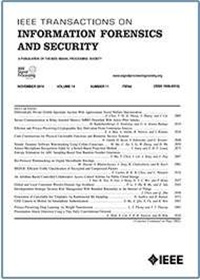基于随机森林的sdn链路泛洪攻击诱饵有效识别
IF 8
1区 计算机科学
Q1 COMPUTER SCIENCE, THEORY & METHODS
IEEE Transactions on Information Forensics and Security
Pub Date : 2025-09-19
DOI:10.1109/TIFS.2025.3612159
引用次数: 0
摘要
软件定义网络(sdn)面临着来自链路泛洪攻击(LFAs)的重大挑战,在LFAs中,恶意机器人以低速率向有限数量的隐藏主机(称为诱饵)泛滥。有效的诱饵识别对于减轻lfa至关重要,并且比传统的机器人检测方法更具资源效率,因为与机器人相比,诱饵数量较少。本文提出了一种新的诱饵识别机制(DIM),该机制利用SDN控制器为关键交换机生成转发规则,使关键交换机能够有效地对诱饵地址进行分类和报告。DIM解决了在保持高分类精度的同时最小化控制器和数据平面之间的通信开销的挑战。它通过将网络划分为更小的区域来优化关键交换机的选择,从而在最大限度地提高监控效率的同时降低通信成本。在每个区域内,DIM为所选交换机预训练随机森林(RF)模型,并生成各自的二进制编码转发规则。这些规则使交换机能够以线路速度识别LFA流量中的诱饵地址。然后将确定的地址报告给DIM以进行进一步分析。理论分析表明,DIM在时间和空间复杂度方面具有有效的尺度。我们对NS-3模拟器的评估——使用真实的CAIDA流量和超过30,000个节点的综合拓扑——表明DIM达到了98.3%的诱饵识别精度,在精度和速度上都优于LSTM和CNN等最先进的模型。在路由变化和移动目标防御场景下的测试证实了DIM的鲁棒性和适应性,突出了其对抗lfa的实际有效性。本文章由计算机程序翻译,如有差异,请以英文原文为准。
Using Random Forests for Efficient Identification of Decoys Under Link Flooding Attacks in SDNs
Software-defined networks (SDNs) face significant challenges from link flooding attacks (LFAs), where malicious bots flood towards a limited number of hidden hosts, known as decoys, at a low rate. Efficient decoy identification is crucial for mitigating LFAs and is more resource-efficient than traditional bot detection methods, given the smaller number of decoys compared to bots. This paper proposes a novel decoy identification mechanism (DIM) that utilizes the SDN controller to generate forwarding rules for critical switches, enabling them to classify and report decoy addresses effectively. DIM addresses the challenges of minimizing communication overhead between the controller and data plane while maintaining high classification accuracy. It optimizes critical switch selection by partitioning the network into smaller areas, which reduces communication costs while maximizing monitoring efficiency. Within each area, DIM pre-trains random forest (RF) models for the selected switches and generates their respective binary-encoded forwarding rules. These rules empower the switches to identify decoy addresses in LFA traffic at line speed. The identified addresses are then reported back to DIM for further analysis. Theoretical analysis demonstrates that DIM scales efficiently in terms of time and space complexity. Our evaluation with the NS-3 simulator—using real CAIDA traffic and a synthesized topology of over 30,000 nodes—shows DIM achieves 98.3% decoy identification accuracy, outperforming state-of-the-art models like LSTM and CNN in both accuracy and speed. Tests under routing changes and moving target defense scenarios confirm DIM’s robustness and adaptability, highlighting its practical effectiveness against LFAs.
求助全文
通过发布文献求助,成功后即可免费获取论文全文。
去求助
来源期刊

IEEE Transactions on Information Forensics and Security
工程技术-工程:电子与电气
CiteScore
14.40
自引率
7.40%
发文量
234
审稿时长
6.5 months
期刊介绍:
The IEEE Transactions on Information Forensics and Security covers the sciences, technologies, and applications relating to information forensics, information security, biometrics, surveillance and systems applications that incorporate these features
 求助内容:
求助内容: 应助结果提醒方式:
应助结果提醒方式:


